Business Law Report: Total and Permanent Disability Insurance Analysis
VerifiedAdded on 2021/06/15
|9
|2176
|137
Report
AI Summary
This business law report provides an in-depth analysis of Total and Permanent Disability (TPD) Insurance. It begins by defining the scope of TPD insurance, differentiating between accident and illness cover, and explaining the benefits provided. The report then delves into the applicability of TPD insurance, outlining the conditions under which it is valid and circumstances where it is not applicable, such as pre-existing medical conditions or criminal activities. Key aspects include the requirement for substantial disability and the legal construction of 'unlikely ever' returning to work. The report also includes case studies like Edwards v The Hunter Valley Co-Op Dairy Limited and Finch v Telstra Super, which highlight the legal precedents and judicial interpretations surrounding TPD insurance, particularly concerning the duties of insurers and trustees. Furthermore, the report discusses the definition of disability and its implications on insurance claims. The conclusion emphasizes the importance of legal tests in assessing TPD and the state's responsibility to ensure financial security for disabled individuals, referencing relevant legislation and court decisions.
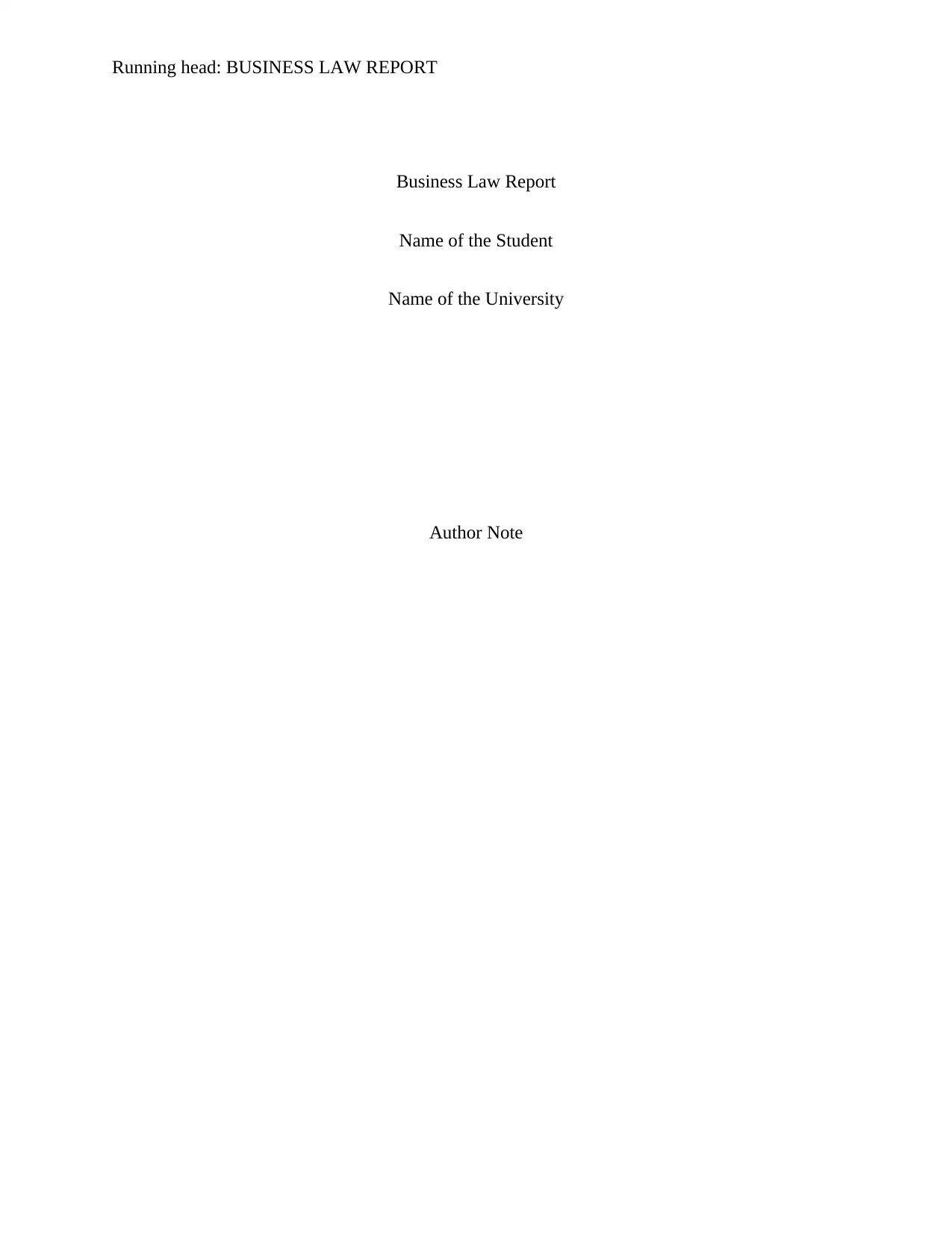
Running head: BUSINESS LAW REPORT
Business Law Report
Name of the Student
Name of the University
Author Note
Business Law Report
Name of the Student
Name of the University
Author Note
Paraphrase This Document
Need a fresh take? Get an instant paraphrase of this document with our AI Paraphraser
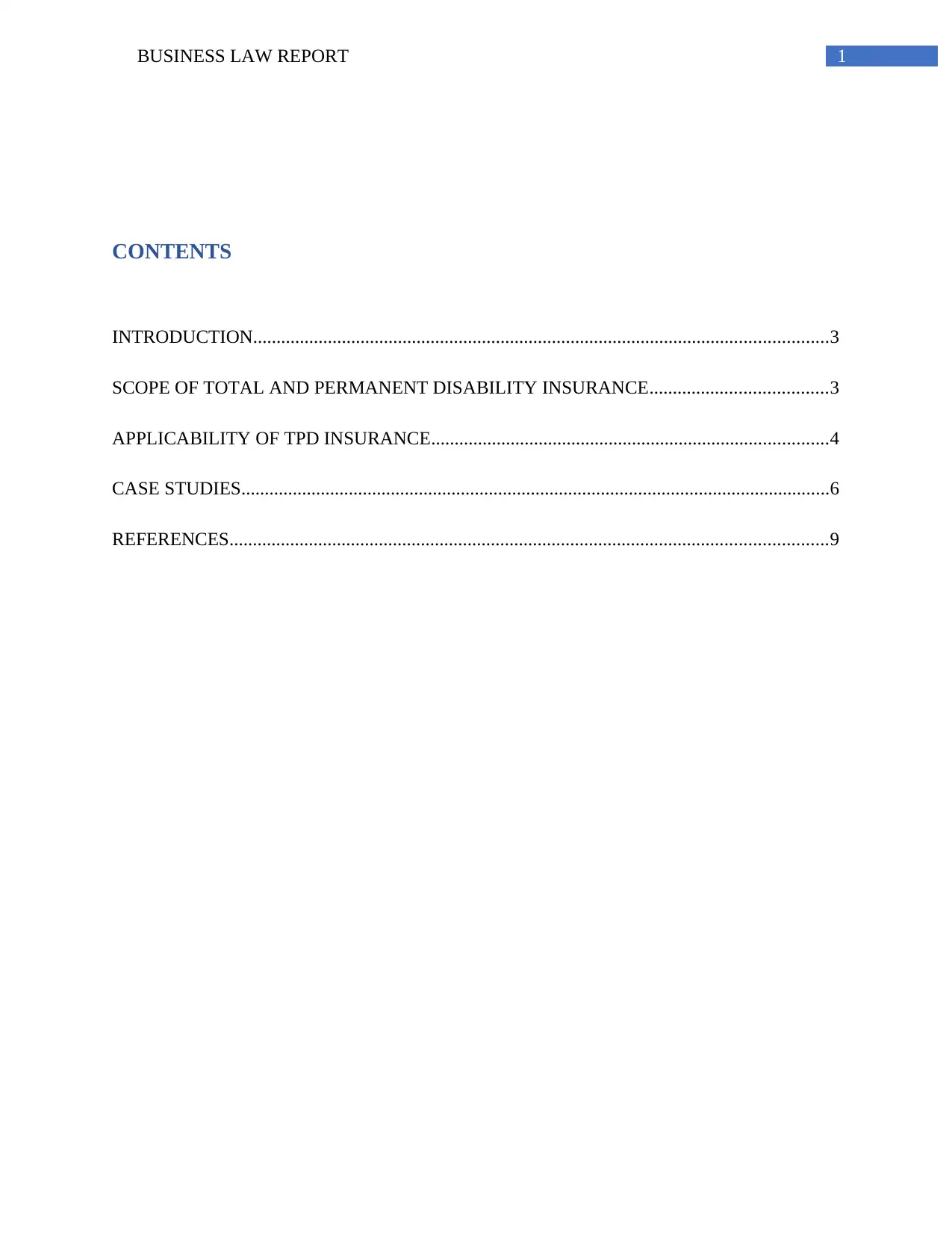
1BUSINESS LAW REPORT
CONTENTS
INTRODUCTION...........................................................................................................................3
SCOPE OF TOTAL AND PERMANENT DISABILITY INSURANCE......................................3
APPLICABILITY OF TPD INSURANCE.....................................................................................4
CASE STUDIES..............................................................................................................................6
REFERENCES................................................................................................................................9
CONTENTS
INTRODUCTION...........................................................................................................................3
SCOPE OF TOTAL AND PERMANENT DISABILITY INSURANCE......................................3
APPLICABILITY OF TPD INSURANCE.....................................................................................4
CASE STUDIES..............................................................................................................................6
REFERENCES................................................................................................................................9
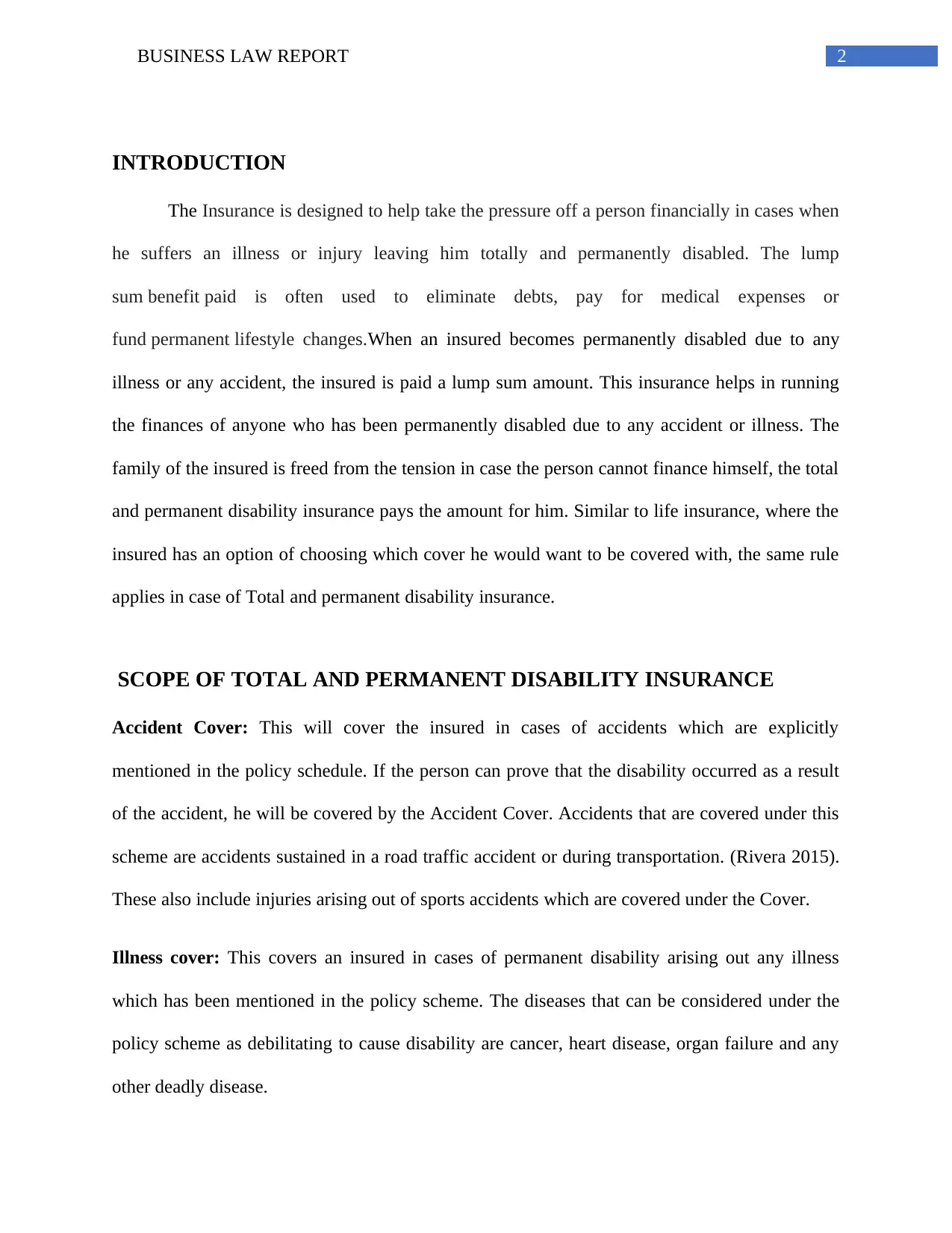
2BUSINESS LAW REPORT
INTRODUCTION
The Insurance is designed to help take the pressure off a person financially in cases when
he suffers an illness or injury leaving him totally and permanently disabled. The lump
sum benefit paid is often used to eliminate debts, pay for medical expenses or
fund permanent lifestyle changes.When an insured becomes permanently disabled due to any
illness or any accident, the insured is paid a lump sum amount. This insurance helps in running
the finances of anyone who has been permanently disabled due to any accident or illness. The
family of the insured is freed from the tension in case the person cannot finance himself, the total
and permanent disability insurance pays the amount for him. Similar to life insurance, where the
insured has an option of choosing which cover he would want to be covered with, the same rule
applies in case of Total and permanent disability insurance.
SCOPE OF TOTAL AND PERMANENT DISABILITY INSURANCE
Accident Cover: This will cover the insured in cases of accidents which are explicitly
mentioned in the policy schedule. If the person can prove that the disability occurred as a result
of the accident, he will be covered by the Accident Cover. Accidents that are covered under this
scheme are accidents sustained in a road traffic accident or during transportation. (Rivera 2015).
These also include injuries arising out of sports accidents which are covered under the Cover.
Illness cover: This covers an insured in cases of permanent disability arising out any illness
which has been mentioned in the policy scheme. The diseases that can be considered under the
policy scheme as debilitating to cause disability are cancer, heart disease, organ failure and any
other deadly disease.
INTRODUCTION
The Insurance is designed to help take the pressure off a person financially in cases when
he suffers an illness or injury leaving him totally and permanently disabled. The lump
sum benefit paid is often used to eliminate debts, pay for medical expenses or
fund permanent lifestyle changes.When an insured becomes permanently disabled due to any
illness or any accident, the insured is paid a lump sum amount. This insurance helps in running
the finances of anyone who has been permanently disabled due to any accident or illness. The
family of the insured is freed from the tension in case the person cannot finance himself, the total
and permanent disability insurance pays the amount for him. Similar to life insurance, where the
insured has an option of choosing which cover he would want to be covered with, the same rule
applies in case of Total and permanent disability insurance.
SCOPE OF TOTAL AND PERMANENT DISABILITY INSURANCE
Accident Cover: This will cover the insured in cases of accidents which are explicitly
mentioned in the policy schedule. If the person can prove that the disability occurred as a result
of the accident, he will be covered by the Accident Cover. Accidents that are covered under this
scheme are accidents sustained in a road traffic accident or during transportation. (Rivera 2015).
These also include injuries arising out of sports accidents which are covered under the Cover.
Illness cover: This covers an insured in cases of permanent disability arising out any illness
which has been mentioned in the policy scheme. The diseases that can be considered under the
policy scheme as debilitating to cause disability are cancer, heart disease, organ failure and any
other deadly disease.
⊘ This is a preview!⊘
Do you want full access?
Subscribe today to unlock all pages.

Trusted by 1+ million students worldwide
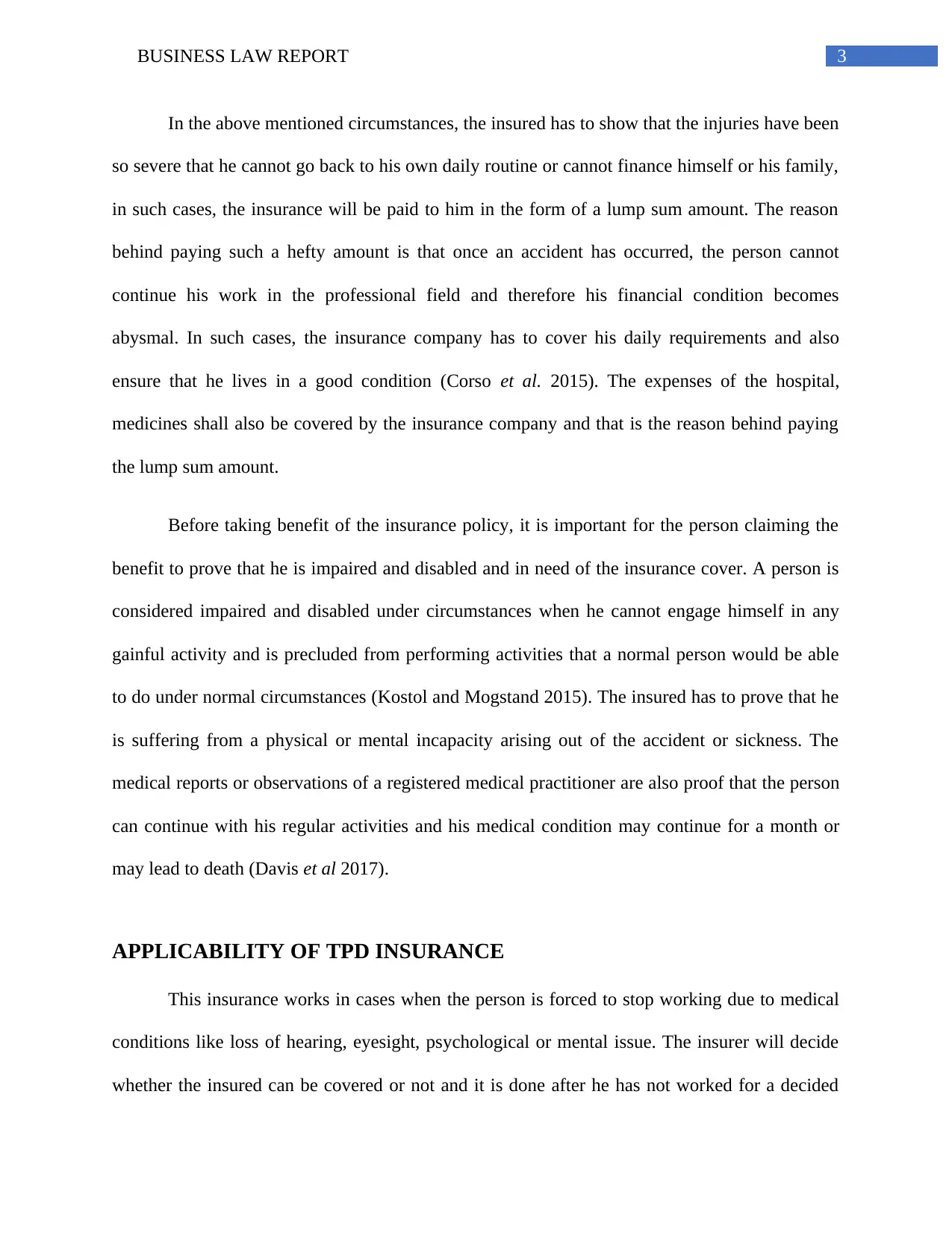
3BUSINESS LAW REPORT
In the above mentioned circumstances, the insured has to show that the injuries have been
so severe that he cannot go back to his own daily routine or cannot finance himself or his family,
in such cases, the insurance will be paid to him in the form of a lump sum amount. The reason
behind paying such a hefty amount is that once an accident has occurred, the person cannot
continue his work in the professional field and therefore his financial condition becomes
abysmal. In such cases, the insurance company has to cover his daily requirements and also
ensure that he lives in a good condition (Corso et al. 2015). The expenses of the hospital,
medicines shall also be covered by the insurance company and that is the reason behind paying
the lump sum amount.
Before taking benefit of the insurance policy, it is important for the person claiming the
benefit to prove that he is impaired and disabled and in need of the insurance cover. A person is
considered impaired and disabled under circumstances when he cannot engage himself in any
gainful activity and is precluded from performing activities that a normal person would be able
to do under normal circumstances (Kostol and Mogstand 2015). The insured has to prove that he
is suffering from a physical or mental incapacity arising out of the accident or sickness. The
medical reports or observations of a registered medical practitioner are also proof that the person
can continue with his regular activities and his medical condition may continue for a month or
may lead to death (Davis et al 2017).
APPLICABILITY OF TPD INSURANCE
This insurance works in cases when the person is forced to stop working due to medical
conditions like loss of hearing, eyesight, psychological or mental issue. The insurer will decide
whether the insured can be covered or not and it is done after he has not worked for a decided
In the above mentioned circumstances, the insured has to show that the injuries have been
so severe that he cannot go back to his own daily routine or cannot finance himself or his family,
in such cases, the insurance will be paid to him in the form of a lump sum amount. The reason
behind paying such a hefty amount is that once an accident has occurred, the person cannot
continue his work in the professional field and therefore his financial condition becomes
abysmal. In such cases, the insurance company has to cover his daily requirements and also
ensure that he lives in a good condition (Corso et al. 2015). The expenses of the hospital,
medicines shall also be covered by the insurance company and that is the reason behind paying
the lump sum amount.
Before taking benefit of the insurance policy, it is important for the person claiming the
benefit to prove that he is impaired and disabled and in need of the insurance cover. A person is
considered impaired and disabled under circumstances when he cannot engage himself in any
gainful activity and is precluded from performing activities that a normal person would be able
to do under normal circumstances (Kostol and Mogstand 2015). The insured has to prove that he
is suffering from a physical or mental incapacity arising out of the accident or sickness. The
medical reports or observations of a registered medical practitioner are also proof that the person
can continue with his regular activities and his medical condition may continue for a month or
may lead to death (Davis et al 2017).
APPLICABILITY OF TPD INSURANCE
This insurance works in cases when the person is forced to stop working due to medical
conditions like loss of hearing, eyesight, psychological or mental issue. The insurer will decide
whether the insured can be covered or not and it is done after he has not worked for a decided
Paraphrase This Document
Need a fresh take? Get an instant paraphrase of this document with our AI Paraphraser
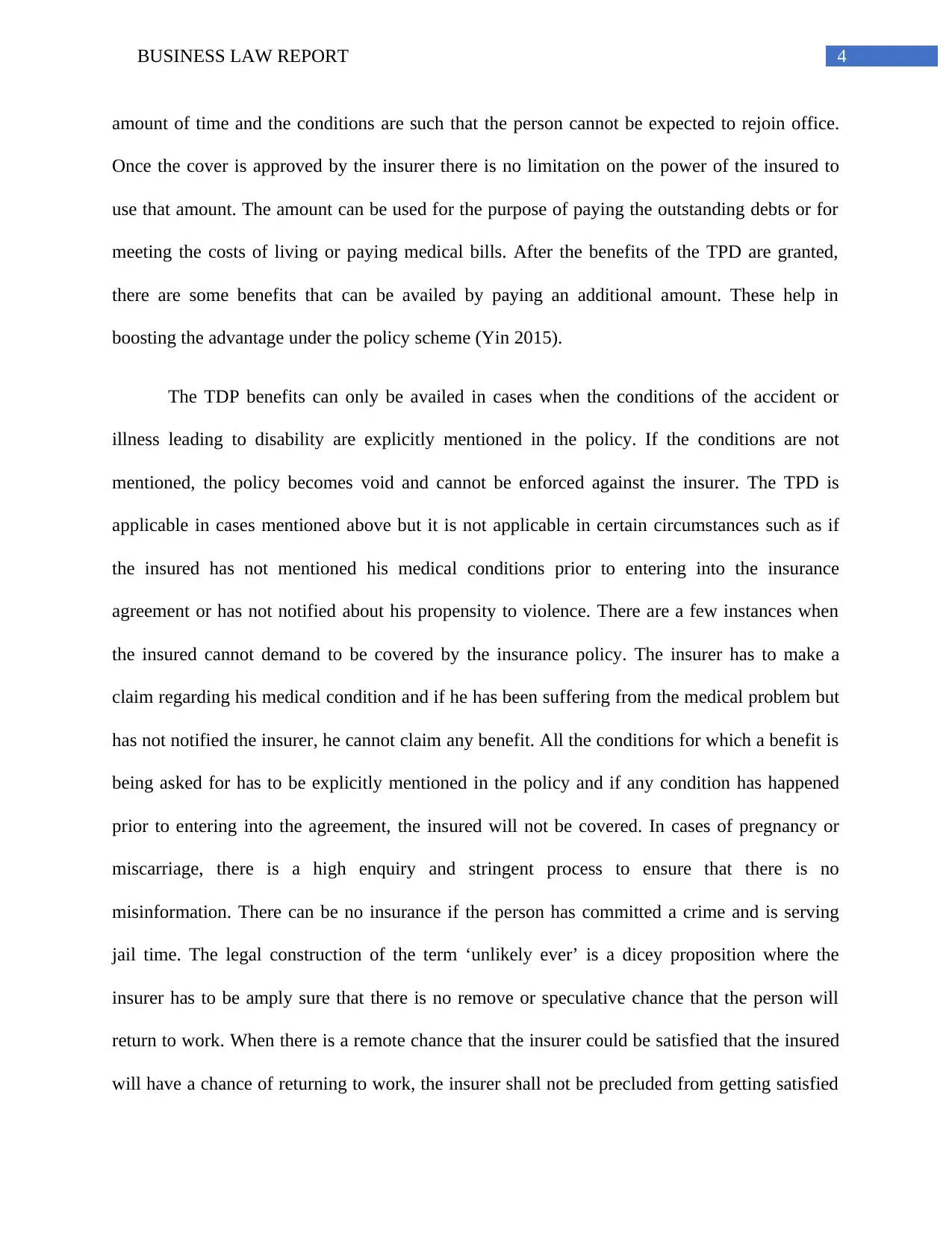
4BUSINESS LAW REPORT
amount of time and the conditions are such that the person cannot be expected to rejoin office.
Once the cover is approved by the insurer there is no limitation on the power of the insured to
use that amount. The amount can be used for the purpose of paying the outstanding debts or for
meeting the costs of living or paying medical bills. After the benefits of the TPD are granted,
there are some benefits that can be availed by paying an additional amount. These help in
boosting the advantage under the policy scheme (Yin 2015).
The TDP benefits can only be availed in cases when the conditions of the accident or
illness leading to disability are explicitly mentioned in the policy. If the conditions are not
mentioned, the policy becomes void and cannot be enforced against the insurer. The TPD is
applicable in cases mentioned above but it is not applicable in certain circumstances such as if
the insured has not mentioned his medical conditions prior to entering into the insurance
agreement or has not notified about his propensity to violence. There are a few instances when
the insured cannot demand to be covered by the insurance policy. The insurer has to make a
claim regarding his medical condition and if he has been suffering from the medical problem but
has not notified the insurer, he cannot claim any benefit. All the conditions for which a benefit is
being asked for has to be explicitly mentioned in the policy and if any condition has happened
prior to entering into the agreement, the insured will not be covered. In cases of pregnancy or
miscarriage, there is a high enquiry and stringent process to ensure that there is no
misinformation. There can be no insurance if the person has committed a crime and is serving
jail time. The legal construction of the term ‘unlikely ever’ is a dicey proposition where the
insurer has to be amply sure that there is no remove or speculative chance that the person will
return to work. When there is a remote chance that the insurer could be satisfied that the insured
will have a chance of returning to work, the insurer shall not be precluded from getting satisfied
amount of time and the conditions are such that the person cannot be expected to rejoin office.
Once the cover is approved by the insurer there is no limitation on the power of the insured to
use that amount. The amount can be used for the purpose of paying the outstanding debts or for
meeting the costs of living or paying medical bills. After the benefits of the TPD are granted,
there are some benefits that can be availed by paying an additional amount. These help in
boosting the advantage under the policy scheme (Yin 2015).
The TDP benefits can only be availed in cases when the conditions of the accident or
illness leading to disability are explicitly mentioned in the policy. If the conditions are not
mentioned, the policy becomes void and cannot be enforced against the insurer. The TPD is
applicable in cases mentioned above but it is not applicable in certain circumstances such as if
the insured has not mentioned his medical conditions prior to entering into the insurance
agreement or has not notified about his propensity to violence. There are a few instances when
the insured cannot demand to be covered by the insurance policy. The insurer has to make a
claim regarding his medical condition and if he has been suffering from the medical problem but
has not notified the insurer, he cannot claim any benefit. All the conditions for which a benefit is
being asked for has to be explicitly mentioned in the policy and if any condition has happened
prior to entering into the agreement, the insured will not be covered. In cases of pregnancy or
miscarriage, there is a high enquiry and stringent process to ensure that there is no
misinformation. There can be no insurance if the person has committed a crime and is serving
jail time. The legal construction of the term ‘unlikely ever’ is a dicey proposition where the
insurer has to be amply sure that there is no remove or speculative chance that the person will
return to work. When there is a remote chance that the insurer could be satisfied that the insured
will have a chance of returning to work, the insurer shall not be precluded from getting satisfied
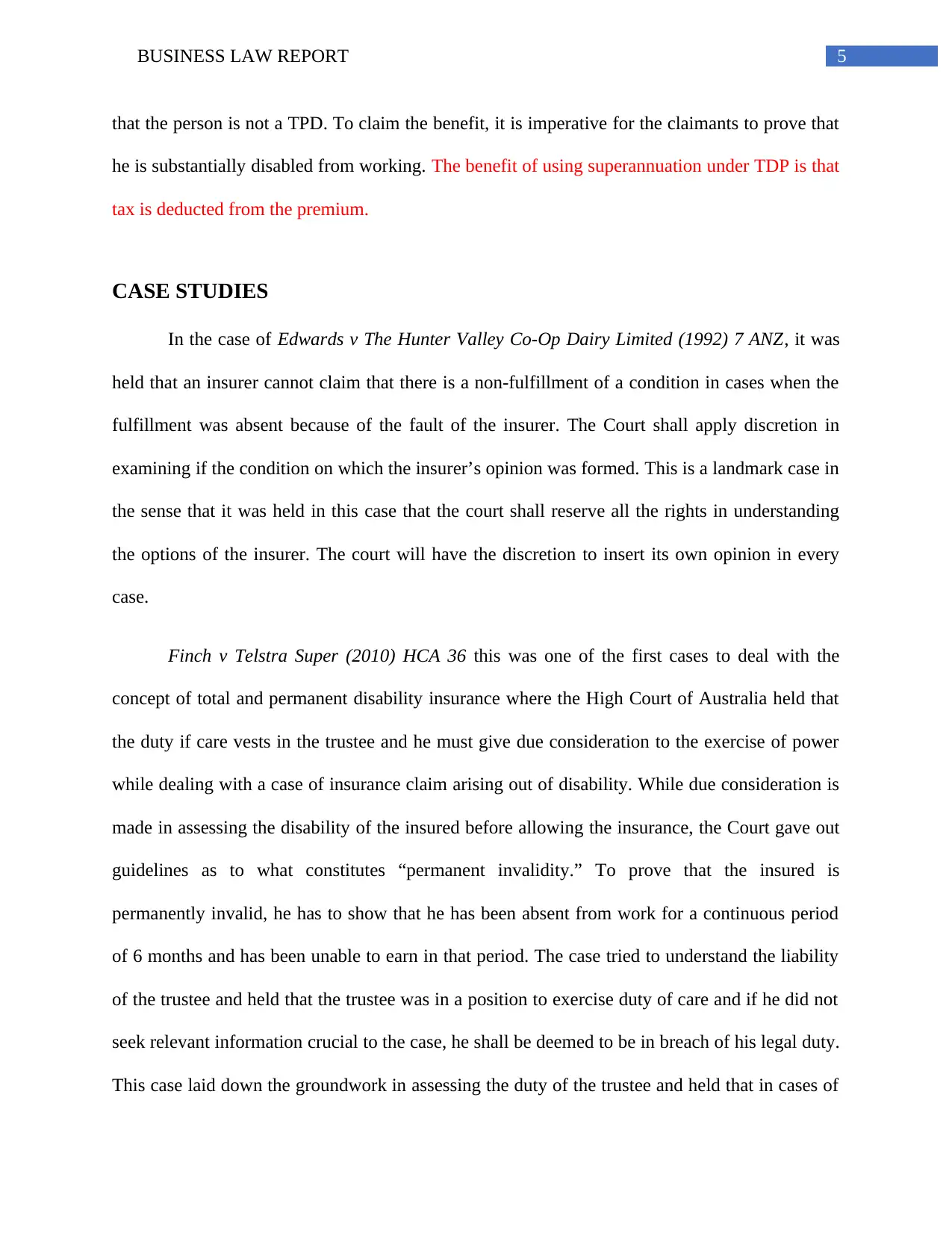
5BUSINESS LAW REPORT
that the person is not a TPD. To claim the benefit, it is imperative for the claimants to prove that
he is substantially disabled from working. The benefit of using superannuation under TDP is that
tax is deducted from the premium.
CASE STUDIES
In the case of Edwards v The Hunter Valley Co-Op Dairy Limited (1992) 7 ANZ, it was
held that an insurer cannot claim that there is a non-fulfillment of a condition in cases when the
fulfillment was absent because of the fault of the insurer. The Court shall apply discretion in
examining if the condition on which the insurer’s opinion was formed. This is a landmark case in
the sense that it was held in this case that the court shall reserve all the rights in understanding
the options of the insurer. The court will have the discretion to insert its own opinion in every
case.
Finch v Telstra Super (2010) HCA 36 this was one of the first cases to deal with the
concept of total and permanent disability insurance where the High Court of Australia held that
the duty if care vests in the trustee and he must give due consideration to the exercise of power
while dealing with a case of insurance claim arising out of disability. While due consideration is
made in assessing the disability of the insured before allowing the insurance, the Court gave out
guidelines as to what constitutes “permanent invalidity.” To prove that the insured is
permanently invalid, he has to show that he has been absent from work for a continuous period
of 6 months and has been unable to earn in that period. The case tried to understand the liability
of the trustee and held that the trustee was in a position to exercise duty of care and if he did not
seek relevant information crucial to the case, he shall be deemed to be in breach of his legal duty.
This case laid down the groundwork in assessing the duty of the trustee and held that in cases of
that the person is not a TPD. To claim the benefit, it is imperative for the claimants to prove that
he is substantially disabled from working. The benefit of using superannuation under TDP is that
tax is deducted from the premium.
CASE STUDIES
In the case of Edwards v The Hunter Valley Co-Op Dairy Limited (1992) 7 ANZ, it was
held that an insurer cannot claim that there is a non-fulfillment of a condition in cases when the
fulfillment was absent because of the fault of the insurer. The Court shall apply discretion in
examining if the condition on which the insurer’s opinion was formed. This is a landmark case in
the sense that it was held in this case that the court shall reserve all the rights in understanding
the options of the insurer. The court will have the discretion to insert its own opinion in every
case.
Finch v Telstra Super (2010) HCA 36 this was one of the first cases to deal with the
concept of total and permanent disability insurance where the High Court of Australia held that
the duty if care vests in the trustee and he must give due consideration to the exercise of power
while dealing with a case of insurance claim arising out of disability. While due consideration is
made in assessing the disability of the insured before allowing the insurance, the Court gave out
guidelines as to what constitutes “permanent invalidity.” To prove that the insured is
permanently invalid, he has to show that he has been absent from work for a continuous period
of 6 months and has been unable to earn in that period. The case tried to understand the liability
of the trustee and held that the trustee was in a position to exercise duty of care and if he did not
seek relevant information crucial to the case, he shall be deemed to be in breach of his legal duty.
This case laid down the groundwork in assessing the duty of the trustee and held that in cases of
⊘ This is a preview!⊘
Do you want full access?
Subscribe today to unlock all pages.

Trusted by 1+ million students worldwide
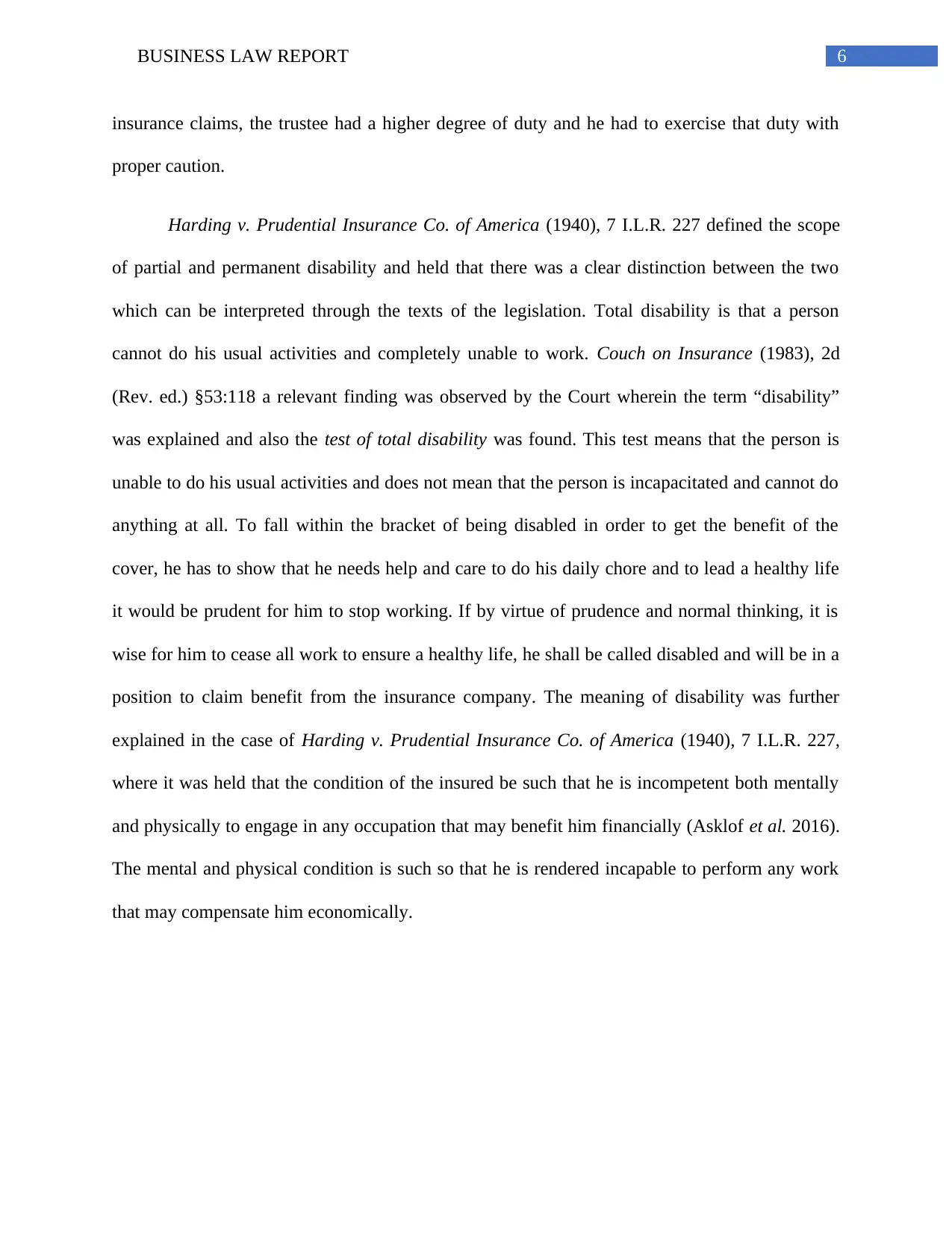
6BUSINESS LAW REPORT
insurance claims, the trustee had a higher degree of duty and he had to exercise that duty with
proper caution.
Harding v. Prudential Insurance Co. of America (1940), 7 I.L.R. 227 defined the scope
of partial and permanent disability and held that there was a clear distinction between the two
which can be interpreted through the texts of the legislation. Total disability is that a person
cannot do his usual activities and completely unable to work. Couch on Insurance (1983), 2d
(Rev. ed.) §53:118 a relevant finding was observed by the Court wherein the term “disability”
was explained and also the test of total disability was found. This test means that the person is
unable to do his usual activities and does not mean that the person is incapacitated and cannot do
anything at all. To fall within the bracket of being disabled in order to get the benefit of the
cover, he has to show that he needs help and care to do his daily chore and to lead a healthy life
it would be prudent for him to stop working. If by virtue of prudence and normal thinking, it is
wise for him to cease all work to ensure a healthy life, he shall be called disabled and will be in a
position to claim benefit from the insurance company. The meaning of disability was further
explained in the case of Harding v. Prudential Insurance Co. of America (1940), 7 I.L.R. 227,
where it was held that the condition of the insured be such that he is incompetent both mentally
and physically to engage in any occupation that may benefit him financially (Asklof et al. 2016).
The mental and physical condition is such so that he is rendered incapable to perform any work
that may compensate him economically.
insurance claims, the trustee had a higher degree of duty and he had to exercise that duty with
proper caution.
Harding v. Prudential Insurance Co. of America (1940), 7 I.L.R. 227 defined the scope
of partial and permanent disability and held that there was a clear distinction between the two
which can be interpreted through the texts of the legislation. Total disability is that a person
cannot do his usual activities and completely unable to work. Couch on Insurance (1983), 2d
(Rev. ed.) §53:118 a relevant finding was observed by the Court wherein the term “disability”
was explained and also the test of total disability was found. This test means that the person is
unable to do his usual activities and does not mean that the person is incapacitated and cannot do
anything at all. To fall within the bracket of being disabled in order to get the benefit of the
cover, he has to show that he needs help and care to do his daily chore and to lead a healthy life
it would be prudent for him to stop working. If by virtue of prudence and normal thinking, it is
wise for him to cease all work to ensure a healthy life, he shall be called disabled and will be in a
position to claim benefit from the insurance company. The meaning of disability was further
explained in the case of Harding v. Prudential Insurance Co. of America (1940), 7 I.L.R. 227,
where it was held that the condition of the insured be such that he is incompetent both mentally
and physically to engage in any occupation that may benefit him financially (Asklof et al. 2016).
The mental and physical condition is such so that he is rendered incapable to perform any work
that may compensate him economically.
Paraphrase This Document
Need a fresh take? Get an instant paraphrase of this document with our AI Paraphraser
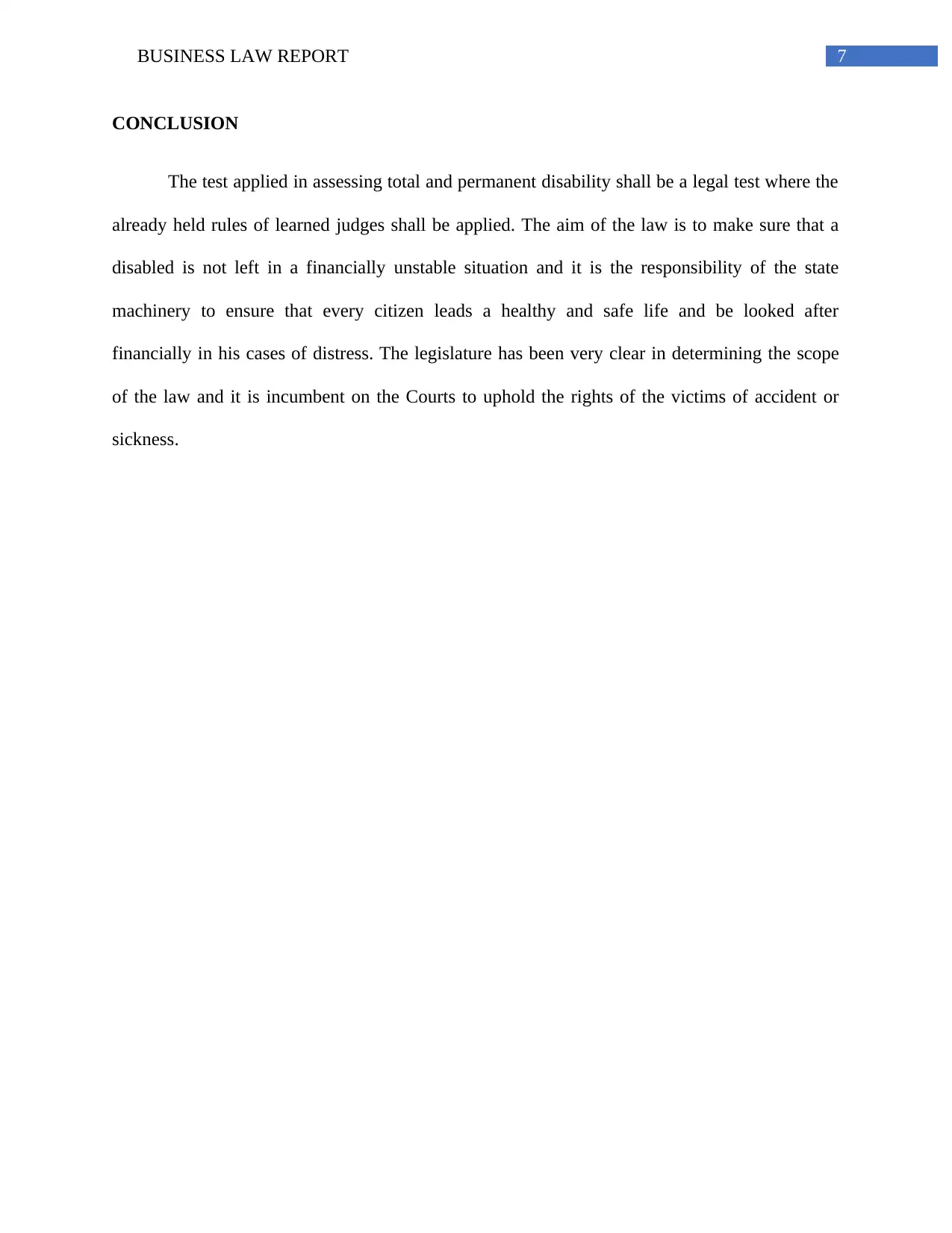
7BUSINESS LAW REPORT
CONCLUSION
The test applied in assessing total and permanent disability shall be a legal test where the
already held rules of learned judges shall be applied. The aim of the law is to make sure that a
disabled is not left in a financially unstable situation and it is the responsibility of the state
machinery to ensure that every citizen leads a healthy and safe life and be looked after
financially in his cases of distress. The legislature has been very clear in determining the scope
of the law and it is incumbent on the Courts to uphold the rights of the victims of accident or
sickness.
CONCLUSION
The test applied in assessing total and permanent disability shall be a legal test where the
already held rules of learned judges shall be applied. The aim of the law is to make sure that a
disabled is not left in a financially unstable situation and it is the responsibility of the state
machinery to ensure that every citizen leads a healthy and safe life and be looked after
financially in his cases of distress. The legislature has been very clear in determining the scope
of the law and it is incumbent on the Courts to uphold the rights of the victims of accident or
sickness.
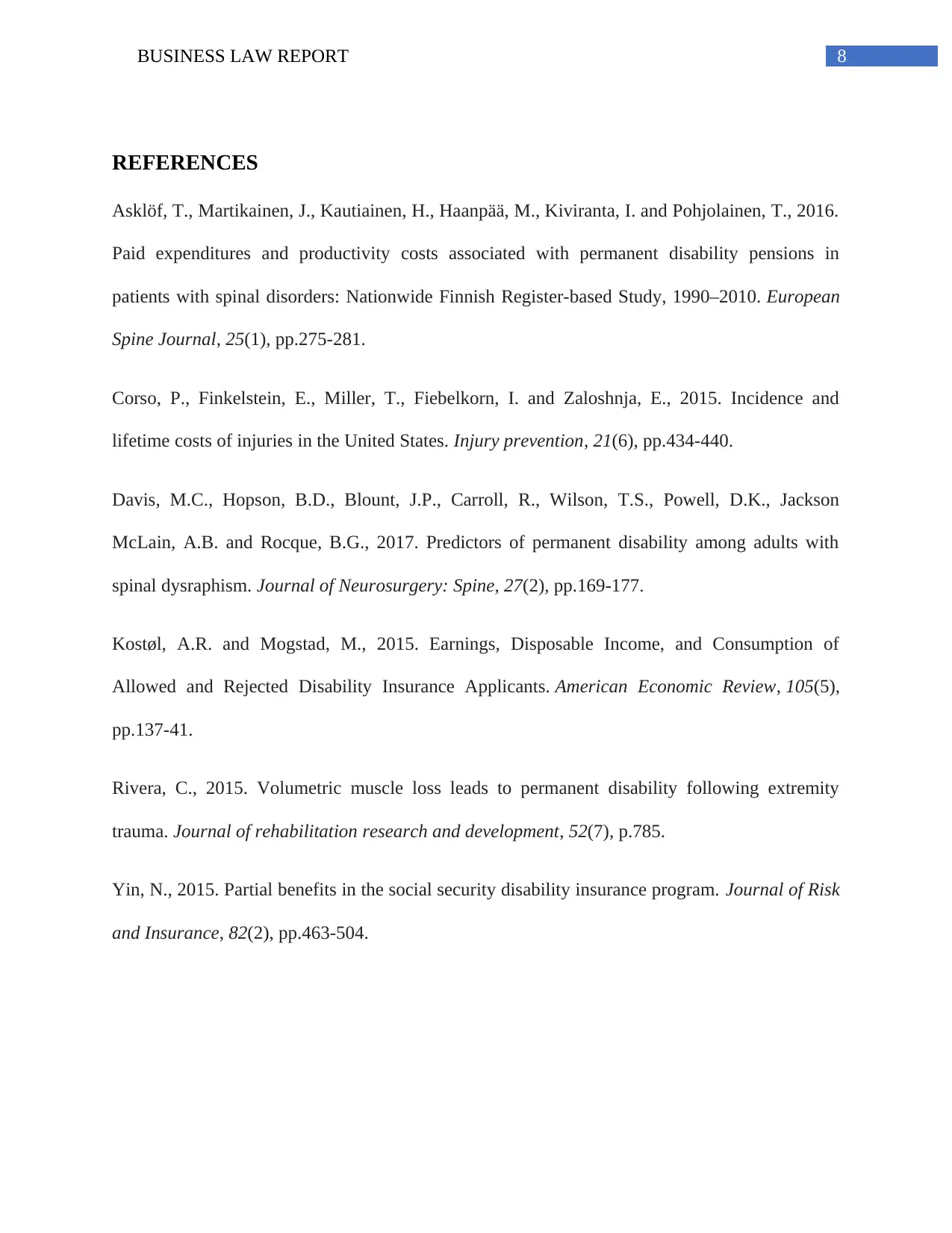
8BUSINESS LAW REPORT
REFERENCES
Asklöf, T., Martikainen, J., Kautiainen, H., Haanpää, M., Kiviranta, I. and Pohjolainen, T., 2016.
Paid expenditures and productivity costs associated with permanent disability pensions in
patients with spinal disorders: Nationwide Finnish Register-based Study, 1990–2010. European
Spine Journal, 25(1), pp.275-281.
Corso, P., Finkelstein, E., Miller, T., Fiebelkorn, I. and Zaloshnja, E., 2015. Incidence and
lifetime costs of injuries in the United States. Injury prevention, 21(6), pp.434-440.
Davis, M.C., Hopson, B.D., Blount, J.P., Carroll, R., Wilson, T.S., Powell, D.K., Jackson
McLain, A.B. and Rocque, B.G., 2017. Predictors of permanent disability among adults with
spinal dysraphism. Journal of Neurosurgery: Spine, 27(2), pp.169-177.
Kostøl, A.R. and Mogstad, M., 2015. Earnings, Disposable Income, and Consumption of
Allowed and Rejected Disability Insurance Applicants. American Economic Review, 105(5),
pp.137-41.
Rivera, C., 2015. Volumetric muscle loss leads to permanent disability following extremity
trauma. Journal of rehabilitation research and development, 52(7), p.785.
Yin, N., 2015. Partial benefits in the social security disability insurance program. Journal of Risk
and Insurance, 82(2), pp.463-504.
REFERENCES
Asklöf, T., Martikainen, J., Kautiainen, H., Haanpää, M., Kiviranta, I. and Pohjolainen, T., 2016.
Paid expenditures and productivity costs associated with permanent disability pensions in
patients with spinal disorders: Nationwide Finnish Register-based Study, 1990–2010. European
Spine Journal, 25(1), pp.275-281.
Corso, P., Finkelstein, E., Miller, T., Fiebelkorn, I. and Zaloshnja, E., 2015. Incidence and
lifetime costs of injuries in the United States. Injury prevention, 21(6), pp.434-440.
Davis, M.C., Hopson, B.D., Blount, J.P., Carroll, R., Wilson, T.S., Powell, D.K., Jackson
McLain, A.B. and Rocque, B.G., 2017. Predictors of permanent disability among adults with
spinal dysraphism. Journal of Neurosurgery: Spine, 27(2), pp.169-177.
Kostøl, A.R. and Mogstad, M., 2015. Earnings, Disposable Income, and Consumption of
Allowed and Rejected Disability Insurance Applicants. American Economic Review, 105(5),
pp.137-41.
Rivera, C., 2015. Volumetric muscle loss leads to permanent disability following extremity
trauma. Journal of rehabilitation research and development, 52(7), p.785.
Yin, N., 2015. Partial benefits in the social security disability insurance program. Journal of Risk
and Insurance, 82(2), pp.463-504.
⊘ This is a preview!⊘
Do you want full access?
Subscribe today to unlock all pages.

Trusted by 1+ million students worldwide
1 out of 9
Related Documents
Your All-in-One AI-Powered Toolkit for Academic Success.
+13062052269
info@desklib.com
Available 24*7 on WhatsApp / Email
![[object Object]](/_next/static/media/star-bottom.7253800d.svg)
Unlock your academic potential
Copyright © 2020–2025 A2Z Services. All Rights Reserved. Developed and managed by ZUCOL.





